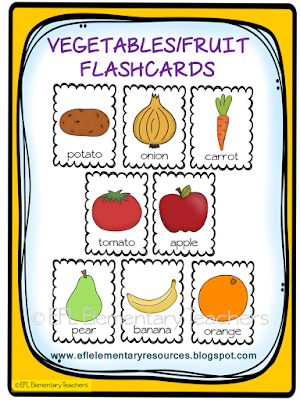I joined both themes, 4 fruit (apple,banana,pear,orange) and 4
veggies
( onion, carrot, potato,tomato).


Nothing like flashcards to introduce the vocabulary words.
GRAPHING.Show the flashcards in random order and one at a time. Have the students stand up if they like the item on the flashcard. Have a student write the results on the board.
Teacher: How many students like apples?
Students: four students!
Use this Domino Game to maintain the learner´s interest.
The cutouts help to create the contexts
in which the vocabulary words become meaningful. The students will participate in
a conversation by expressing information.
You can print all the puzzle
pieces in 11 different colored construction paper. Place a fruit or vegetable
on each color.
Teacher: Where is the onion ?
Student: It is on yellow.
Teacher: What is next to the onion ?
Student: a potato on blue.
Teacher: pear!
Student: on orange.
Use the cutouts for introducing This/ These.
And for sorting fruit and vegetables. Hand in all the cutouts to random students. Write fruit and vegetables on the board and tell them that at your signal they have to run to the board and place them where they belong.
And for more practice of the
vocabulary words ,a match game. Make it motivating. Provide more language practice using
the cards in speaking and listening. It can be a game played in pairs asking
simple questions. Student 1 who asks the questions has to place the cards in a
Yes pile or a No pile, then see how many cards are in each pile.
Student 1: Do you like bananas ?
Student 2: Yes, I do/ No, I don´t.
And for reading and writing.
Make a print of the cards for
each group in class. Have the children in the group shuffle all the cards and
place them face down on the table. One student turns two cards and reads or
says what is on each card. If the cards are a match, he/she keeps them. If not,
the cards must be returned to the table. All students must play. When all the
cards are gone from the table, the students have to write a sentence on their
notebooks with the cards they have.
Encourage students to interact with
the shopping lists. Print all the cutouts or have play food toys available in
class. One group will be the shoppers and another will be the sellers. You can
have many shops and many shoppers. Hand in each student a shopping list card
and the other group the food, not all the food has to be available in all the
shops.
The buyers have to go to shopping.
Student Shopper: Do you have tomatoes?
Student Seller: Yes, I do. Here!
Student Shopper: Do you have bananas ?
Student Seller: No, I don´t. Sorry! ( moves on to
another shop)
I know that you are always
looking for worksheets. Here are 6 of them. Worksheets are good for individual
quiet time. Go around asking questions about the pictures. Use them to review
written grammar points. Do your own worksheets
and place them on the board so the students can do self-check.
Worksheet 1 and 2:
Worksheet 3 and 4:
Worksheet 5 and 6:
Pocket charts are good for students that finish first and need more activities. If you don´t have a pocket chart just have them do the matching on a table or the floor.































